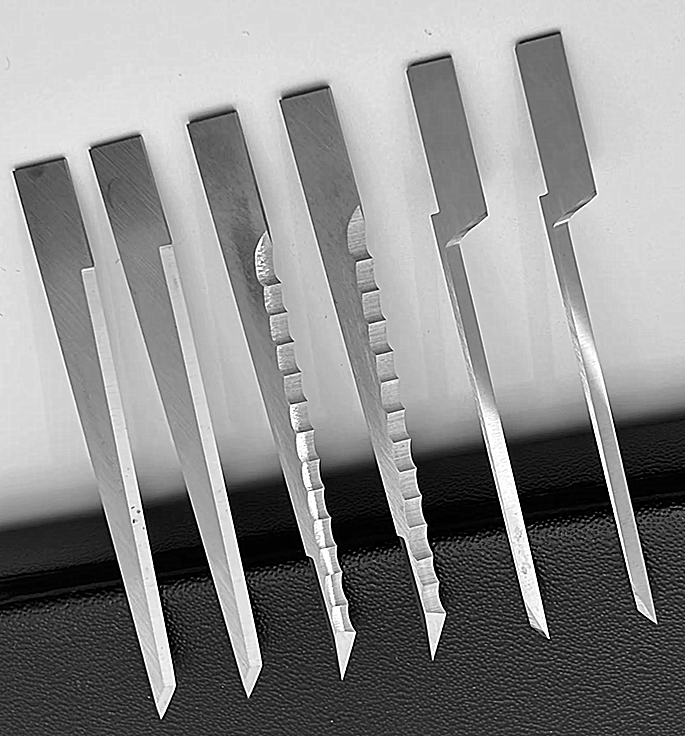Tungsten carbide blades stand out in the industrial world for their unmatched hardness and durability, serving as indispensable tools in applications like cutting, drilling, and sawing. Their robust nature ensures reliability and efficiency, but like any tool, they are not immune to wear and tear. Over time, even these high-performance blades lose their sharp edge, necessitating regular maintenance to keep them functioning at their best. Sharpening tungsten carbide blades is no simple task—it's a demanding process due to their incredible toughness. However, with the right techniques and specialized equipment, restoring their edge becomes a manageable and cost-effective endeavor. Whether it's for professional-grade tools or precision machinery, companies like Shenzhen Oyea Machinery Co., Ltd ensure that tungsten carbide blades continue to serve industries with consistent excellence.
Methods for Sharpening Tungsten Carbide Blades
Various techniques are available for sharpening tungsten carbide blades, each offering distinct advantages and limitations.
一,.Diamond Grinding Wheels
Diamond grinding wheels are widely regarded as the most effective tool for sharpening tungsten carbide blades. Since diamond is one of the few substances harder than tungsten carbide, these wheels enable precise grinding with minimal wear.
Advantages:
- High Precision: Diamond grinding wheels ensure excellent control during sharpening, allowing the blade's angle and edge to be maintained flawlessly.
- Long Durability:These wheels are highly resistant to wear and provide a long service lifespan, even with repeated use.
- Efficiency:Using diamond wheels significantly speeds up the sharpening process, restoring blade sharpness in less time.
Instructions for Use:
1. Position the blade at the appropriate angle against the diamond wheel.
2. Use a coolant during sharpening to prevent overheating, which can compromise the integrity of tungsten carbide.
3. Apply steady and consistent pressure to achieve a sharply honed edge.
二,Silicon Carbide Grinding Wheels
Silicon carbide grinding wheels offer a cost-effective alternative to diamond wheels, although they are less suited for rigorous sharpening tasks.
Benefits:
- Affordable:These wheels are more budget-friendly compared to diamond options.
- Accessible:Ideal for lighter sharpening needs and widely available.
How to Use:
1. Position the blade at the appropriate angle for grinding.
2. Apply steady and even pressure throughout the process.
3. Monitor the blade temperature to prevent overheating during grinding.
三,Electrical Discharge Machining (EDM)
Electrical Discharge Machining utilizes electrical pulses to gradually erode material from the blade surface, making it suitable for creating intricate designs.
Benefits:
- High Precision: Allows for detailed work on complex shapes without introducing mechanical stress.
- Minimal Stress:Reduces the likelihood of deformation or unwanted damage.
How to Use:
1. Secure the blade in the EDM machine.
2. Use controlled electrical discharges to efficiently erode the material along the edge.
四,Laser Sharpening
Laser sharpening employs concentrated laser beams to precisely sharpen blades, ensuring no physical contact with the material.
Benefits:
- Extreme Precision: Achieves exceptional sharpness with exact control.
- No Physical WearPrevents mechanical wear or risk of damage during the process.
- Efficiency:Perfect for high-output manufacturing environments due to its speed.
How to Use:
1. Focus the laser beam precisely on the blade’s edge.
2. Vaporize small amounts of the material to achieve refined sharpness.
Critical Factors for Sharpening Tungsten Carbide Blades
Cooling
Preventing overheating is vital when sharpening tungsten carbide blades, as excessive heat can lead to microcracks that compromise blade durability. Utilizing coolants ensures temperature control and maintains structural integrity during the process.
Correct Sharpening Angle
Preserving the blade's geometry requires maintaining the proper sharpening angle. Achieving precision is easier by using a guide or fixture, especially when consistent sharpness is necessary.
Sharpening Frequency
Proper upkeep involves regular sharpening to avoid a complete loss of edge sharpness. Addressing wear early enhances efficiency and extends the blade's overall lifespan.
Quality of Sharpening Tools
Effective sharpening demands high-grade tools, such as diamond or silicon carbide grinding wheels. Using unsuitable abrasives not only hinders performance but may also result in blade damage.
In conclusion, Shenzhen Oyea Machinery Co., Ltd emphasizes the importance of using specialized tools and techniques when sharpening tungsten carbide blades, given their exceptional hardness and durability. For achieving both precision and efficiency, diamond grinding wheels are the optimal choice, whereas silicon carbide wheels serve as a more budget-friendly option for less demanding sharpening tasks. Advanced methods such as EDM (Electrical Discharge Machining) and laser sharpening stand out as excellent solutions for situations requiring utmost precision. Consistent maintenance and adherence to proper sharpening practices remain essential in prolonging the operational lifespan and performance of these blades. Shenzhen Oyea Machinery Co., Ltd remains dedicated to delivering high-quality solutions tailored to meet diverse sharpening needs.
Methods for Sharpening Tungsten Carbide Blades
Various techniques are available for sharpening tungsten carbide blades, each offering distinct advantages and limitations.
一,.Diamond Grinding Wheels
Diamond grinding wheels are widely regarded as the most effective tool for sharpening tungsten carbide blades. Since diamond is one of the few substances harder than tungsten carbide, these wheels enable precise grinding with minimal wear.
Advantages:
- High Precision: Diamond grinding wheels ensure excellent control during sharpening, allowing the blade's angle and edge to be maintained flawlessly.
- Long Durability:These wheels are highly resistant to wear and provide a long service lifespan, even with repeated use.
- Efficiency:Using diamond wheels significantly speeds up the sharpening process, restoring blade sharpness in less time.
Instructions for Use:
1. Position the blade at the appropriate angle against the diamond wheel.
2. Use a coolant during sharpening to prevent overheating, which can compromise the integrity of tungsten carbide.
3. Apply steady and consistent pressure to achieve a sharply honed edge.
二,Silicon Carbide Grinding Wheels
Silicon carbide grinding wheels offer a cost-effective alternative to diamond wheels, although they are less suited for rigorous sharpening tasks.
Benefits:
- Affordable:These wheels are more budget-friendly compared to diamond options.
- Accessible:Ideal for lighter sharpening needs and widely available.
How to Use:
1. Position the blade at the appropriate angle for grinding.
2. Apply steady and even pressure throughout the process.
3. Monitor the blade temperature to prevent overheating during grinding.
三,Electrical Discharge Machining (EDM)
Electrical Discharge Machining utilizes electrical pulses to gradually erode material from the blade surface, making it suitable for creating intricate designs.
Benefits:
- High Precision: Allows for detailed work on complex shapes without introducing mechanical stress.
- Minimal Stress:Reduces the likelihood of deformation or unwanted damage.
How to Use:
1. Secure the blade in the EDM machine.
2. Use controlled electrical discharges to efficiently erode the material along the edge.
四,Laser Sharpening
Laser sharpening employs concentrated laser beams to precisely sharpen blades, ensuring no physical contact with the material.
Benefits:
- Extreme Precision: Achieves exceptional sharpness with exact control.
- No Physical WearPrevents mechanical wear or risk of damage during the process.
- Efficiency:Perfect for high-output manufacturing environments due to its speed.
How to Use:
1. Focus the laser beam precisely on the blade’s edge.
2. Vaporize small amounts of the material to achieve refined sharpness.
Critical Factors for Sharpening Tungsten Carbide Blades
Cooling
Preventing overheating is vital when sharpening tungsten carbide blades, as excessive heat can lead to microcracks that compromise blade durability. Utilizing coolants ensures temperature control and maintains structural integrity during the process.
Correct Sharpening Angle
Preserving the blade's geometry requires maintaining the proper sharpening angle. Achieving precision is easier by using a guide or fixture, especially when consistent sharpness is necessary.
Sharpening Frequency
Proper upkeep involves regular sharpening to avoid a complete loss of edge sharpness. Addressing wear early enhances efficiency and extends the blade's overall lifespan.
Quality of Sharpening Tools
Effective sharpening demands high-grade tools, such as diamond or silicon carbide grinding wheels. Using unsuitable abrasives not only hinders performance but may also result in blade damage.
In conclusion, Shenzhen Oyea Machinery Co., Ltd emphasizes the importance of using specialized tools and techniques when sharpening tungsten carbide blades, given their exceptional hardness and durability. For achieving both precision and efficiency, diamond grinding wheels are the optimal choice, whereas silicon carbide wheels serve as a more budget-friendly option for less demanding sharpening tasks. Advanced methods such as EDM (Electrical Discharge Machining) and laser sharpening stand out as excellent solutions for situations requiring utmost precision. Consistent maintenance and adherence to proper sharpening practices remain essential in prolonging the operational lifespan and performance of these blades. Shenzhen Oyea Machinery Co., Ltd remains dedicated to delivering high-quality solutions tailored to meet diverse sharpening needs.
PREV : Zund Multipurpose Router Zund Acm Router Zund Acrylic Aluminium Router Differences And Models NEXT : Zund R108 R141 R202 R203 R204 R208 R209 R503 router bits for zund






